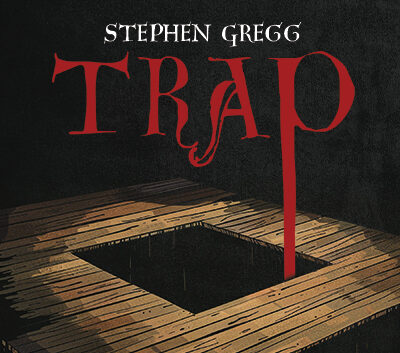The latest production by the Vashon High School theater, a multi-layered horror mystery called TRAP, was ambitious and unparalleled in its creativity. Written by Steven Gregg, directed by Andy James and performed by the tight-knit VHS theater troupe over the span of two weekends, this was probably their most ambitious production I’ve seen yet. Its conceit is that it’s a play within a play, where something goes horribly wrong. And on top of that, its non-chronological story is told through reenacted, live interviews, CCTV footage, and recorded phone calls, as if it was a documentary.
TRAP leaps between times, places and perspectives to tell the eerie story of a multi-casualty incident at a historical theater. Midway through this fictional high school production (the one inside the play), every person in the audience fell unconscious, except for one, leaving seats full of comatose theatergoers and a seemingly unexplainable mystery. So, as the small town races to save the lives of the victims under the national spotlight, the truth is slowly revealed. And, surprisingly, it’s more confusing than the mystery itself.
Before you fully figure out what happened, the fourth wall corrodes until the audience becomes the victims of the incident. It gets to the point where the actors are literally screaming at you to leave your seats and get out “before it’s too late.”
Although the eventual descent into meta-madness was the most interesting part of TRAP, some intriguing aspects of the mystery were sacrificed for it. I’m somewhat torn on whether I would have preferred it to stay more within the bounds of a conventional play and give a more fulfilling payoff, or dedicate fully to the meta as it did. I think if it did the former, I wouldn’t still be thinking about TRAP.
The unsettling erosion of the fourth-wall initially feels a bit gimmicky, but as the story evolves it becomes a powerful metaphor for the experience of making and viewing theater. When you see a play, it’s not just the performers taking a risk, the audience is as well. It may feel purely transactional, especially if it’s a professional production. You don’t have a stake in it, you don’t know anyone onstage, and there’s nothing you’re risking but your time. We’re used to the safety of the fourth-wall; we can always retreat and cower behind it if things go wrong. But in the act of just paying attention to what’s before you, and living in the moment, you’re putting a huge amount of trust into dozens of strangers. Trust that they will play by the rules, and stay on their side of the wall. In most cases, we can rely on this assumption. In most cases, we are safe. But in TRAP, you are taking a risk just by investing your time, and you can’t trust it. You are not only the viewer; you’re the subject, the victim even.
This subversion of expectation leads to a heightened sense of unease. You don’t know where danger or scares could come from. Typically, you’ll have your senses attuned to the stage at all times. But in TRAP, this tunnel vision isn’t present. There are sounds and senses all around you, so you never know where to look, or if the performers will stay within their corral.
Sound enveloped the crowd, everything from unsettling whispers to a bone-rattling fog horn. Andy James described how he went about achieving this, saying, “There were speakers positioned in rooms around the theater. There were a lot of XLR cables in the show covering a lot of ground. There was a speaker above the audience where 1940s music would come from. The foghorn was coming from the right side. There was also a Bluetooth speaker in the audience that on closing night, I finally dialed in so that it was whispering things that the students had recorded, like, “this is high school play.”
Along with this use of audio, certain elements of the stage design were intentionally confusing. The lighting was low, almost obscuring the stage. Mr. James said he “wanted it to be frustratingly dark, because you’re trying to figure out what’s going on there. It’s meant to be security footage.”
As for the other half of the play which takes place through video interviews, Mr. James favored the opposite, saying “We put three lights downstage to make it look like someone was shining a studio light in the actors’ faces.” This was very effective. The monologues felt claustrophobic and uncomfortably intimate. In the fluorescent spotlight, the actors had nothing and nobody to fall back on.
Andy James described the message of TRAP, saying “There’s kind of a contract with an audience that you get to narrow your vision to just see what’s on the stage. In fact, that’s what you’re supposed to do. You’re not supposed to be aware of the people around you or the things going on around you. And we won’t intrude on that. And so we had a good reason to break that contract.
I don’t know if I will ever see another play quite like TRAP. It’s rare to see such antagonizing, frustrating art that maintains a purpose. It’s so easy for this kind of postmodern, meta-storytelling to become self-serving. Stuck in a cycle of self-referential irony, artists will turn to this childish nihilism in an attempt to one up their last fourth-wall breaking quip, until there’s no meaning left at all. But TRAP had a purpose, it used its resources wisely, and ended up being an unforgettable production.
